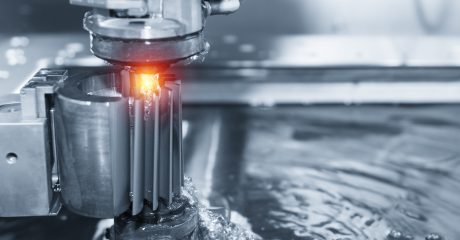Need high accuracy from a challenging machining application? Electrical discharge machining (EDM) is the ticket. It’s also known as arc machining, spark machining and burning, and the superb surface finish, small heat-affected zone and ability to cut exotic alloys are a few key perks of the process. Electrical discharge machining works by passing an electrical current through a dielectric liquid from an electrode to a workpiece. The fluid acts an insulator until voltage is high enough to cause ionization and turn the fluid into a conductor. The spark discharge erodes the workpiece into the planned shape. Die sinker/“ram,” wire/“cheese cutter” and hole drilling/“hole popper” are the top three EDM strategies.
Die Sinker “Ram” EDM
This category of EDM was actually invented twice, by two different groups of people, at the same time. In an effort to expand the lifespan of tungsten breaker points, Russian scientists discovered that immersion in dielectric fluid combatted erosion. As a result, a spark-based machining process, also known as a resistor-capacitor (R-C) circuit for EDM, was born.
On the other side of the pond, an American team sought a process to remove broken drills and taps. Members of the team considered using sparks to eliminate them, but the idea didn’t get traction until they decided to use water as a coolant. This process became the foundation for the vacuum-tube EDM. This system increased the spark frequency more than 16 times over!
Today, die sinker EDM is essential in metal stamping, plastic injection molds and other complex cavity shapes in tool and die applications. Graphite electrodes create a positive of the intended cavity and inserting the electrode into the workpiece creates sparks on the surface.
Wire or “Cheese Cutter” EDM
It took a decade to create wire EDM as an improved method to make hardened steel dies. Using a thin wire as an electrode (by moving it in a controlled pattern similar to a scroll saw) facilitates sparks between the wire and the desired workpiece, and a constantly moving spool of wire keeps a fresh discharge path.
The downside is that the wire must pass completely through the workpiece. Consequently, it must make a two-dimensional cut in a part that is three dimensions.
Hole Drilling or “Hole Popper” EDM
Pre-drilling a starter hole in the workpiece enables wire insertion for the wire EDM operation, but pre-drilling isn’t always possible with blind hole applications. Hole drilling EDMs are pretty handy!
A rotating conductive tube becomes the electrode here, combined with a constant flow of dielectric fluid (often deionized water) to flush the cut. Create the starter hole for wire threading with this method.
In machining, we are always searching for ways to make more accurate and precise holes, especially in exotic and hardened materials. Therefore, advanced technologies like EDM cooling holes for jet engines came to be. Cooling holes in high temperature alloy turbine blades lead to a film cooling process and effective jet engine operation at higher temperatures.
Take Advantage of Electrical Discharge Machining Technology
At Custom Tool, we utilize the advanced technology at our disposal to make perfect custom tools for your needs. Visit our website and request a quote to learn more.
